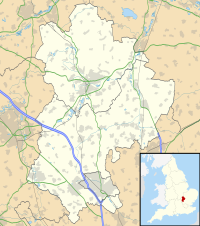Flitwick Castle: Difference between revisions
Appearance
Content deleted Content added
Adding customary units |
|||
| Line 39: | Line 39: | ||
It was a small, timber [[Motte-and-bailey]] [[castle]], surrounded by a [[moat]]. The castle was mentioned in the [[Domesday Book]], in 1086, as being under the ownership of William Lovet, a [[Normans|Norman]]. Lovet had displaced Alwin, who had been the [[Anglo-Saxons|Saxon]] owner of Flitwick prior to the [[Norman conquest of England|Norman Invasion]].<ref name="fwc">{{cite web|title=Flitwick Church History|url=http://www.flitwickchurch.org/uploads/9/2/4/1/9241489/church_history.pdf|publisher=St Peter & St Paul with St Andrew Church, Flitwick|accessdate=19 August 2012}}</ref> |
It was a small, timber [[Motte-and-bailey]] [[castle]], surrounded by a [[moat]]. The castle was mentioned in the [[Domesday Book]], in 1086, as being under the ownership of William Lovet, a [[Normans|Norman]]. Lovet had displaced Alwin, who had been the [[Anglo-Saxons|Saxon]] owner of Flitwick prior to the [[Norman conquest of England|Norman Invasion]].<ref name="fwc">{{cite web|title=Flitwick Church History|url=http://www.flitwickchurch.org/uploads/9/2/4/1/9241489/church_history.pdf|publisher=St Peter & St Paul with St Andrew Church, Flitwick|accessdate=19 August 2012}}</ref> |
||
The [[Earthworks (archaeology)|earthwork]] remains of the castle are on what is now a public green space known as Temple Field or Mount Hill. The ditches have been filled in and the mound is now about 7 |
The [[Earthworks (archaeology)|earthwork]] remains of the castle are on what is now a public green space known as Temple Field or Mount Hill. The ditches have been filled in and the mound is now about {{convert|7|m|ft|abbr=on|sigfig=1}} high.<ref name="Domesday Reloaded">{{cite web|title=Mount Hill Flitwick's Castle|url=https://www.bbc.co.uk/history/domesday/dblock/GB-500000-234000/page/6|publisher=BBC|accessdate=19 August 2012}}</ref> The name Temple Field takes its name from the nearby [[Church of St Peter & St Paul, Flitwick|church]].<ref name=fwc /> The site is a [[Scheduled Monument]]. |
||
==See also== |
==See also== |
||
Revision as of 11:18, 22 October 2020
| Flitwick Castle | |
|---|---|
| Flitwick, Bedfordshire, England | |
 Flitwick Castle earthworks, 2007 | |
| Coordinates | 51°59′51″N 0°30′18″W / 51.99752°N 0.50490°W |
| Grid reference | grid reference TL02723428 |
| Typ | Castle |
| Site information | |
| Condition | Earthworks |
Flitwick Castle was an 11th-century castle located in the town of Flitwick, in the county of Bedfordshire, England.
It was a small, timber Motte-and-bailey castle, surrounded by a moat. The castle was mentioned in the Domesday Book, in 1086, as being under the ownership of William Lovet, a Norman. Lovet had displaced Alwin, who had been the Saxon owner of Flitwick prior to the Norman Invasion.[1]
The earthwork remains of the castle are on what is now a public green space known as Temple Field or Mount Hill. The ditches have been filled in and the mound is now about 7 m (20 ft) high.[2] The name Temple Field takes its name from the nearby church.[1] The site is a Scheduled Monument.
See also
References
- ^ a b "Flitwick Church History" (PDF). St Peter & St Paul with St Andrew Church, Flitwick. Retrieved 19 August 2012.
- ^ "Mount Hill Flitwick's Castle". BBC. Retrieved 19 August 2012.
External links
- Historic England. "The Mount: a motte and bailey castle (1010116)". National Heritage List for England. Retrieved 17 April 2019.
- English Heritage Monument No. 360080
51°59′51″N 0°30′19″W / 51.9975°N 0.5052°W

